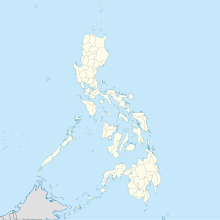
Back Ninoy Aquino Internasionale Lughawe Afrikaans مطار نينوي أكوينو الدولي Arabic مطار نينوى اكوينو الدولى ARZ Aeropuertu Internacional Ninoy Aquino AST Pankinàban na Palayogan nin Ninoy Aquino BCL Tugpahanang Pangkalibutanon sa Ninoy Aquino CEB Mezinárodní letiště Manila Czech Ninoy Aquino International Airport German Aeropuerto Internacional Ninoy Aquino Spanish Ninoy Aquino rahvusvaheline lennujaam Estonian
Ninoy Aquino International Airport Paliparang Pandaigdig ng Ninoy Aquino | |||||||||||||||
|---|---|---|---|---|---|---|---|---|---|---|---|---|---|---|---|
 | |||||||||||||||
 Aerial view of NAIA from northeast in 2023. | |||||||||||||||
| Summary | |||||||||||||||
| Airport type | Public / Military | ||||||||||||||
| Owner | Manila International Airport Authority | ||||||||||||||
| Operator | New NAIA Infrastructure Corporation | ||||||||||||||
| Serves | Greater Manila Area | ||||||||||||||
| Location | Parañaque and Pasay, Metro Manila, Philippines | ||||||||||||||
| Opened | 1948 | ||||||||||||||
| Hub for | |||||||||||||||
| Operating base for | |||||||||||||||
| Built | 1919 | ||||||||||||||
| Time zone | PHT (UTC+08:00) | ||||||||||||||
| Elevation AMSL | 23 m / 75 ft | ||||||||||||||
| Coordinates | 14°30′30″N 121°01′11″E / 14.50833°N 121.01972°E | ||||||||||||||
| Website | www | ||||||||||||||
| Maps | |||||||||||||||
 | |||||||||||||||
 | |||||||||||||||
| Runways | |||||||||||||||
| |||||||||||||||
| Statistics (2023) | |||||||||||||||
| |||||||||||||||
Ninoy Aquino International Airport (NAIA /nɑː.ˈiː.jə/ NA-ee-YAH; Filipino: Paliparang Pandaigdig ng Ninoy Aquino; IATA: MNL, ICAO: RPLL), also known as Manila International Airport (MIA), is the main international airport serving Metro Manila in the Philippines. Located between the cities of Pasay and Parañaque, about 7 kilometers (4.3 mi) south of Manila proper and southwest of Makati, it is the main gateway for travelers to the Philippines and serves as a hub for PAL Express and Philippine Airlines. It is also the main operating base for AirSWIFT, Cebgo, Cebu Pacific, and Philippines AirAsia.
Manila International Airport was officially renamed for former Philippine senator Benigno "Ninoy" Aquino Jr.,[3] who was assassinated at the airport on August 21, 1983. NAIA is managed by the Manila International Airport Authority (MIAA), an agency of the Department of Transportation (DOTr).[4] It is currently operated by the New NAIA Infrastructure Corporation (NNIC), a subsidiary of San Miguel Corporation.
NAIA and Clark International Airport in Clark Freeport Zone, Pampanga, both serve the greater metropolitan area. Clark caters mainly to low-cost carriers because its landing fees have been lower ever since former president Gloria Macapagal Arroyo called for Clark to replace NAIA as the Philippines' primary airport.[5] NAIA is operating beyond its designed capacity of 35 million passengers, clogging air traffic and delaying flights.[6] As a result, it has consistently been ranked as one of the world's worst airports.[7][8][9][10] In response, a private consortium has been overseeing the airport's operation and rehabilitation since September 14, 2024.[11] Two nearby construction projects meant to reduce congestion at NAIA are also underway: one being the New Manila International Airport in Bulakan, Bulacan and the other being to upgrade Sangley Point Airport in Cavite City into an international airport.[12]
In 2023, NAIA served 45.3 million passengers, forty-seven percent more than the previous year, making it the busiest airport in the Philippines,[13] the 15th busiest in Asia, and the 38th busiest in the world.[14]
Cite error: There are <ref group=lower-alpha> tags or {{efn}} templates on this page, but the references will not show without a {{reflist|group=lower-alpha}} template or {{notelist}} template (see the help page).
- ^ Cite error: The named reference
stats-mnlwas invoked but never defined (see the help page). - ^ Cite error: The named reference
cargowas invoked but never defined (see the help page). - ^ Cite error: The named reference
GovPH-RA6639was invoked but never defined (see the help page). - ^ "Creating the Manila International Airport Authority, Transferring Existing Assets of the Manila International Airport to the Authority, and Vesting the Authority with Power to Administer and Operate the Manila International Airport". Official Gazette of the Republic of the Philippines. Republic of the Philippines. March 4, 1982. Archived from the original on October 16, 2021. Retrieved October 24, 2013.
- ^ G. M. A. News (January 29, 2008). "Arroyo wants DMIA become top airport amid plan to close NAIA". GMA News Online. Retrieved May 21, 2023.
- ^ Mateo, Jan Victor R. "Uncertain future: What's next for NAIA?". Philstar.com. Retrieved May 4, 2023.
- ^ Cite error: The named reference
worstwas invoked but never defined (see the help page). - ^ Luna, Franco (May 27, 2022). "NAIA tagged as worst business class airport in the world in int'l study". Philstar. Retrieved February 2, 2023.
- ^ Purnell, Kristofer (November 26, 2022). "NAIA ranked 3rd 'most stressful airport' in Asia, Oceania — study". Philstar. Retrieved February 2, 2023.
- ^ Rosales, Elijah Felice (November 5, 2024). "NAIA remains worst airport, study shows". The Philippine Star. Retrieved November 5, 2024.
- ^ Dela Cruz, Raymond Carl (January 13, 2023). "DOTr 'fast-tracking' NAIA privatization". Philippine News Agency. Retrieved February 2, 2023.
- ^ "Consortium Backed By Billionaire Lucio Tan's MacroAsia Wins $11 Billion Philippine Airport Project". Forbes. September 16, 2022. Retrieved October 13, 2022.
- ^ "NAIA surpasses pre-pandemic passenger volume in 2023". ABS-CBN News. January 6, 2024. Retrieved January 11, 2024.
- ^ "2023 Airport Traffic Report" (PDF). Port Authority of New York and New Jersey. April 2024. p. 32.




